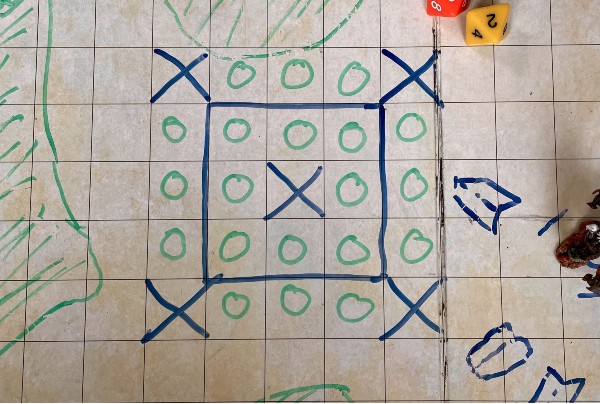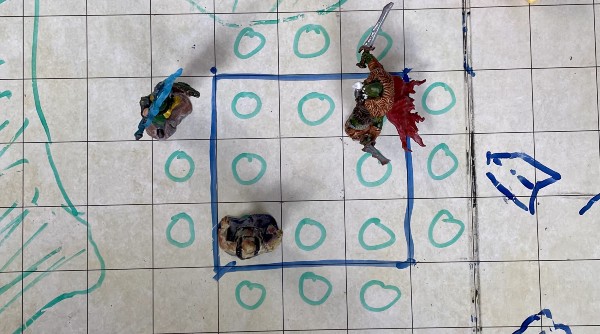A wave of thunderous force sweeps out from you. Each creature in a 15-foot cube originating from you must make a Constitution saving throw. On a failed save, a creature takes 2d8 thunder damage and is pushed 10 feet away from you. On a successful save, the creature takes half as much damage and isn’t pushed.
In addition, unsecured objects that are completely within the area of effect are automatically pushed 10 feet away from you by the spell’s effect, and the spell emits a thunderous boom audible out to 300 feet.
At Higher Levels. When you cast this spell using a spell slot of 2nd level or higher, the damage increases by 1d8 for each slot level above 1st.
Casting Time: 1 action
Range: Self (15-foot cube)
Components: V, S
Duration: Instantaneous
School: 1st-level evocation
Who can cast Thunderwave? Bards, Druids, Sorcerers, and Wizards have Thunderwave on their class spell lists. Tempest Clerics, Armorer Artificers and Artillerist Artificers get Thunderwave for free and always have it prepared. Fathomless Warlocks and Genie Warlocks (Djinni) have Thunderwave on their expanded class spell lists.
Thunderwave 5e
Thunderwave is a powerful evocation spell in the early levels. It offers significant area of effect damage as well as battlefield control. That being said, Thunderwave comes with some drawbacks and contentious rules once you dig deeper.
We’ll cover the basics of Thunderwave, as well as ways to optimize your use of the spell. I’ll also clear up some common rule misconceptions and show some of the extra utility that Thunderwave offers.
How Does Thunderwave Work in 5e?
Thunderwave forces each creature in a 15-foot cube emanating from you to make a Constitution saving throw. If they fail, they take 2d8 (9 average) thunder damage and are pushed back 10 feet. If they pass, they take half as much damage and aren’t pushed.
Unsecured objects in the cube are automatically pushed. Finally — and this part is one you don’t want to forget on stealth missions — Thunderwave can be heard up to 300 feet away.
What Are the Rules for Thunderwave in 5e?
The rules for Thunderwave in DnD 5e are as follows:
-
All creatures, including allies, must make a Constitution saving throw or take half damage and be forced 10 feet away from the spell’s point of origin.
-
A cube originating from you does not mean you are the center of the cube. Rather, you are the “point of origin” for one face of the cube. Here’s more from Jeremy Crawford on Sage Advice.
A range of self means the caster is the target, as in shield, or the point of origin, as in thunderwave (PH, 202). https://t.co/pojyAyYVoL
— Jeremy Crawford (@JeremyECrawford) June 3, 2015
In other words, your space is the point of origin.
-
You can hit yourself with Thunderwave. You can choose to include the space you’re standing on (the point of origin) in the spell’s effect if you choose. That’s just how cube-shaped area-of-effect spells work in DnD 5e (PHB 204).
-
Thunderwave is audible for 300 feet, which is bigger than most battle maps — that means far-off foes may come check things out.
Let’s look at how Thunderwave’s area of effect works with some visuals. In the illustrations below, “C” refers to the Caster, and Xs refer to squares affected by Thunderwave. This is how all cube-based, self-ranged spells work:
-
_XXX
CXXX
_XXX
-
CXXX
_XXX
_XXX
-
CXX
XXX
XXX
-
XXX
CXX
XXX
You can place C anywhere on the perimeter or just outside of the perimeter, but not at the center. Here’s Jeremy Crawford confirming this on Sage Advice.
That's correct. A cube's point of origin needn't be in the center of one of the cube's faces. #DnD https://t.co/jbPHUY6feG
— Jeremy Crawford (@JeremyECrawford) January 25, 2016
That’s because, for cubes (and all area of effect spell shapes), “point of origin is not included in the cube’s area of effect, unless you decide otherwise” (PHB 204). When the caster (C) is part of the 3×3 square affected by Thunderwave, their square is also affected by the spell’s effect.
Does Thunderwave damage you if you use it like in example 3 or 4? Yes, it should damage any creature in the 15-foot cube, including allies and yourself. That still begs the question of how it would push the player, since there are an infinite number of ways to be “pushed 10 feet away” from yourself.
The most common-sense approach would be that the center of the 3×3 cube is where the force is the greatest, and so the caster is pushed away from that point.
At the end of the day, it’s up to DM discretion. There aren’t many situations where extending Thunderwave’s range out from the caster is a bad thing, so it shouldn’t be a problem. This point of contention mostly comes up when a player is trying to avoid damaging an ally by placing Thunderwave closer to themselves.
Can you lie prone and cast Thunderwave up to avoid the damage while still centering it on yourself? Many players on the internet seem to think so, and the 3D nature of a cube does seem to suggest this is possible. The opposite also seems possible (jumping and readying Thunderwave beforehand to give yourself a 10-foot jump boost).
5e’s developers have yet to weigh in on these issues explicitly, so it’s up to you and your table.
How to Use Thunderwave in 5e
Thunderwave has ample uses in DnD 5e, both in and out of combat. Here are some fun ways to use Thunderwave to great effect:
-
Blast loads of baddies. The most obvious application of an area-of-effect damaging spell is blowing up big groups of enemies. Thunderwave does a solid average damage of 9 at level 1 to opponents who fail their save. That means you can potentially deal 81 damage in one spell cast at level 1 (although it would take a huge, densely-packed group of enemies, all with terrible Consitution modifiers).
-
Lion King style cliff tosses. If you’ve got your enemy trapped in a high space with no room to run, Thunderwave can push them off the side, potentially ending the fight really quickly (or at least giving you a big advantage). A variant of this would be blasting an enemy into a trap previously set up by yourself or an ally.
-
Pushing enemies into hazardous terrain. Thunderwave is great in conjunction with long-term damage or control effects that occupy an area, like Spike Growth, Spirit Guardians, or Web. If you can deal Thunderwave’s damage and get extra damage or control by pushing an enemy into such an area, you’ll multiply the value of your spell slot (and your allies who set those spells up will love you).
-
Causing a distraction. Thunderwave’s audible component opens up some interesting tactical options. Maybe you want to draw the hordes of undead to one room so you can Fireball them all at once. Or perhaps you’d like to trick the guards into abandoning their post.
-
Sounding an alarm. DMs won’t allow for groups to communicate if they’ve split up (unless they have Sending Stones), but Thunderwave allows you to send an audible message a long distance. This can be the signal to start the attack, to meet at the rendevous point, or to complete their part in the mission.
-
Getting attention. Whether a packed room of nobles is too busy arguing to listen, a city sleeps while danger approaches, or some other situation arises where a literal “bang” is what you need to get eyes on you, Thunderwave is wonderful for that.
-
Pushing people away. Thunderwave is good if you need to Disengage, but also really want to deal damage. Once enemies are blasted away, they can’t take opportunity attacks against you when you run away from them.
Who Can I Target With Thunderwave 5e?
Thunderwave targets a 15-foot cube emanating from the caster. On a battle map, this can be represented by 3×3 squares of 5 feet each.
As detailed above, Thunderwave is not centered on the caster, but rather emanates from them. As per the rules in the Player’s Handbook regarding area of effect spells, a caster may always choose to include the point of origin in the spell’s effect range. Since the player is the point of origin, you can include yourself in the spell’s area of effect.
Thunderwave deals damage and blasts creatures away indiscriminately; even allies must make a Constitution saving throw or take full damage and be pushed 10 feet from you.
Is Thunderwave 5e a Good Spell?
Yes, Thunderwave is inarguably a good spell. 2d8, area of effect damage affecting 15 cubic feet at first level is quite potent, even without the potential knockback effect.
The major downsides of Thunderwave are threefold:
-
It causes a loud sound that carries a very long distance, meaning it’s not suited for stealth missions in the slightest (unless used as a distraction).
-
It blasts unsecured objects away as well. This might cause unforeseen collateral damage or cause more of a ruckus than you intended.
-
You have to watch out for allies when you use Thunderwave, unless you’re an Evocation Wizard and can protect your allies with Sculpt Spells.
If you’re able to work around these problems, Thunderwave is a solid spell into the midgame, as an extra 1d8 damage per upcast level keeps it competitive.
Thunderwave 5e DM Tips
Hopefully, the rules laid out above have cleared up how Thunderwave’s cube area of effect works. That’s the biggest point of confusion around Thunderwave, especially with new players.
An intuitive reading might suggest Thunderwave is centered on the player, which actually makes the spell weaker in most scenarios. If anything, this reading of the rules should be welcome news for your players.
Other than that, be sure to have fun making players pay for failing to consider Thunderwave’s massive audible range. In some scenarios, it might make sense to rule that stone walls or rushing water muffles the sound and reduces that range. But when you want to introduce a horde of baddies to short-sighted parties, each cast of Thunderwave opens up that door.
DnD 5e Thunderwave FAQ
Thunderwave DnD 5e FAQ:
-
Does Thunderwave damage the caster? No, Thunderwave does not damage the caster unless they choose to include their own space in the spell’s area of effect.
-
Does Thunderwave affect allies? Yes, Thunderwave affects all creatures, including allies, within its area of effect. It deals damage and can potentially push them away.
-
Does Thunderwave end a grapple? Yes, Thunderwave can end a grapple if the grappler is pushed out of reach of the grappled creature. The forced movement from the spell can break the grapple.



![Spike Growth 5e [DnD Spell Guide: Uses, Rules, Tips] entangle-5e-druid](https://www.dndlounge.com/wp-content/uploads/2022/03/entangle-5e-druid-300x174.jpg)
![Shillelagh 5e [DnD Spell Guide: Uses, Rules, Tips] owlbear-dnd-5e](https://www.dndlounge.com/wp-content/uploads/2022/03/owlbear-dnd-5e-300x218.jpg)
![Shape Water 5e [DnD Spell Guide: Uses, Rules, Tips] dnd-5e-character-sheet-and-die](https://www.dndlounge.com/wp-content/uploads/2022/03/dnd-5e-character-sheet-and-die-300x157.jpg)
![Aura of Vitality 5e [DnD Spell Guide: Uses, Rules, Tips] dungeons-and-dragons-party-vs-blue-dragon](https://www.dndlounge.com/wp-content/uploads/2022/03/dungeons-and-dragons-party-vs-blue-dragon-300x223.jpg)